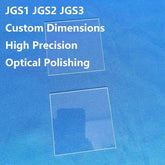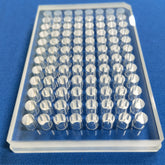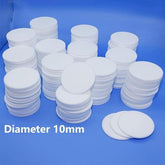Detailed Explanation of Sapphire Glass: The Perfect Combination of High Hardness and High Light Transmittance
1. The definition and introduction of sapphire glass
Sapphire glass, despite the inclusion of the word “glass” in its name, is distinctly different from traditional glass. Sapphire glass is a single crystal material formed by the crystallization of high-purity aluminium oxide (Al2O3) at high temperatures. Its notable features include extremely high hardness, excellent abrasion resistance and outstanding light transmittance, making it an essential component in high-performance material applications.
2. Physical and chemical properties of sapphire glass
(1) Hardness
The Mohs hardness of sapphire glass is 9, second only to that of diamond. This renders the material highly durable in various high-wear applications and suitable for scenarios that require extremely high wear resistance, such as smartphone screens and high-end watch surfaces.

(2) Transmission of light
Sapphire glass is characterized by its exceptional light transmittance across the visible light and near-infrared wavelength ranges. This renders it highly effective in optical applications, such as high-precision optical devices and high-resolution displays.
(3) Coefficient of thermal expansion
Sapphire glass possesses an extremely low coefficient of thermal expansion (approximately 5.0x10⁻⁶/K), a property that ensures its dimensions remain constant when subjected to changes in temperature. This characteristic renders sapphire glass of significant importance in precision optical and electronic devices.
(4) Electrical and thermal conductivity
Sapphire glass is characterized by low electrical conductivity and high thermal conductivity. Its low electrical conductivity renders it suitable for utilization as an insulating material in high-voltage applications, while its high thermal conductivity facilitates the dissipation of heat in high-power equipment.

3. Applications
(1) The screens of smart phones and watches
Sapphire glass, renowned for its exceptional hardness and scratch resistance, is a preferred material for the screens of high-end smartphones and watches. It enhances the durability of the device and offers excellent optical performance, ensuring a clearer display effect.
(2) High-end optical devices
Sapphire glass is utilized in the production of high-precision camera lenses and various optical components, ensuring superior optical performance and durability. Its high light transmittance and low scattering make it an ideal choice for high-resolution optical systems.
(3) Semiconductor equipment
In semiconductor manufacturing, sapphire glass is used as an insulating substrate and protective cover to ensure the stable operation of equipment in high-temperature and high-electric field environments. Its excellent thermal conductivity and low electrical conductivity make it perform well in these applications.

(4) Aerospace
Sapphire glass is utilized to safeguard the precision optical sensors on spacecraft and satellites, thereby ensuring their continued functionality in harsh environments. Its wear resistance and corrosion resistance make it an ideal material for these applications.
(5) Medical devices
Sapphire glass is utilized in the fabrication of precision medical instruments, including endoscopes and microscopes. Its high light transmittance and wear resistance have been demonstrated to enhance the imaging quality and the service life of the equipment, ensuring its reliability in medical diagnosis.






